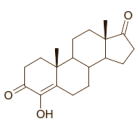|
Definition: "An ergogenic aid is any substance or phenomenon that enhances performance "
|
|
||||||||
23.08.2012 |
|
|
What Syntrax Tetrabol really contained
According to the manufacturer, the active ingredient in Tetrabol was the THP-ether of androst-4-ene-3,17-diol, a testosterone analogue which can be up to 60 percent as effective as testosterone. Androst-4-Ene-3,17-Diol was sold in the US as a pro-hormone until George Bush banned most pro-hormones in 2004.
Like testosterone, androst-4-ene-3,17-diol is not very suitable for oral use. Syntrax solved this problem by attaching a THP-ether to androst-4-ene-3, 17-diol. Animal studies done in the sixties showed that this improves the oral availability of steroid hormones. We don't actually believe this trick works in humans. The human stomach is so acid that THP-ether groups are soon separated from the steroid.
The formula of the substance that Syntrax said was in Tetrabol is shown below.
The big problem with labels in the land of supplements is that they are not always correct – and this was the case for Tetrabol too. Tetrabol actually contained a mixture of two compounds (1:1) shown above.
Chemists refer to both these compounds as 17-hydroxyandrosta-3,5-diene-17-THP. The difference between the two compounds is the way in which the ether is attached to the steroid.
When the researchers studied what happens when humans take 17-hydroxyandrosta-3,5-diene-17-TH, they discovered five metabolites in their test subjects' urine. One of these you may be familiar with: 4-hydroxy-androstenedione, which is marketed as the anti-oestrogen Formestane, the structural formula of which is shown above.
Three of the metabolites had an androgenic effect, the researchers discovered. The strongest effect came from 4-OH-androst-4-ene-3,17-dione.
An analogue of 17-hydroxyandrosta-3,5-diene is still on the market. Physique Enhancing Science's Erase and Erase Pro contain androsta-3,5-diene-7,17-dione.
Source:
More:
|
|




